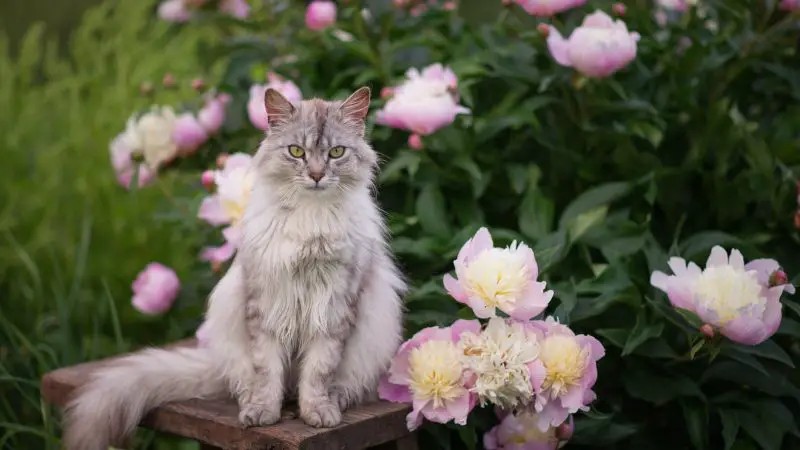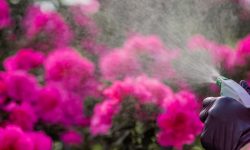Few flowers capture the heart quite like the peony. With its lush, fragrant blooms and romantic charm, this garden favorite graces spring and early summer with breathtaking beauty. But for cat owners, beauty must be balanced with caution. If your curious feline likes to nibble on plants, it’s natural to wonder—are peonies safe to grow around cats?
The answer isn’t simple, and understanding the risks could make all the difference for your pet’s health. Whether you already have peonies blooming in your yard or are considering adding them to your garden, this guide will walk you through everything you need to know—from toxicity risks and symptoms to safer alternatives and tips for pet-friendly gardening. Because your cat’s safety is as important as your love for flowers.
Understanding Peonies and Their Appeal

What Are Peonies?
Peonies are iconic flowering plants from the Paeonia genus, cherished for their lush, layered petals and heady fragrance. Blooming from late spring to early summer, they appear in herbaceous, tree, and intersectional varieties. Their wide color range—from soft blush to deep crimson—makes them a standout in gardens and floral design. Despite their charm, cat owners should know that all parts of the peony plant contain toxic compounds to felines if ingested.
Why Peonies Are Popular in Gardens
Gardeners favor peonies for more than just beauty. These hardy perennials require little maintenance, resist pests, and return year after year with larger blooms. Their resilience and long life—often lasting 50 years or more—make them a staple in temperate-zone landscapes. Plus, peonies attract bees and beneficial insects, promoting a healthier garden ecosystem. Yet if you own cats, their outdoor presence should be carefully managed.
Common Uses of Peonies in Homes
Peonies are often brought indoors for their romantic appearance and long-lasting blooms. They’re popular in wedding arrangements, centerpieces, and spring décor. But when used inside homes with pets, especially cats, caution is essential. Even a fallen petal or leaf can pose a mild risk. Understanding peony toxicity to cats is vital for any pet-loving household that wants to enjoy these blooms safely.
Are Peonies Poisonous to Cats?
Yes—peonies are considered mildly toxic to cats. While they may not cause life-threatening poisoning, the plant contains a compound that can trigger uncomfortable and sometimes distressing symptoms in felines. This makes peonies a hidden hazard in homes and gardens shared with cats, especially those that like to chew on greenery. Understanding the risks can help you create a safe environment for your pets while still enjoying the beauty of this beloved flower.
The Toxic Compound in Peonies
Peonies contain a naturally occurring compound called paeonol, most concentrated in the roots and bark, though smaller amounts are found in the leaves, stems, and petals. Paeonol is known for its anti-inflammatory and antioxidant effects in traditional medicine, but it can have the opposite impact on cats. When ingested, paeonol can irritate the mucous membranes of the digestive tract, causing gastrointestinal upset. While the toxin is not considered highly potent, cats are particularly sensitive to many plant chemicals, making even small doses a concern.
How Peonies Affect Cats
When a cat nibbles or chews on parts of a peony plant—especially the flowers or tender leaves—it may ingest enough paeonol to cause acute digestive symptoms. The most common signs of peony poisoning in cats include:
Vomiting
Diarrhea
Drooling or foaming at the mouth
Mild lethargy or weakness
Symptoms usually appear within a few hours after ingestion and can range from mild to moderate depending on the quantity consumed and the individual cat’s sensitivity. Kittens, elderly cats, or cats with underlying health conditions may be more vulnerable. Most cases resolve within 24–48 hours with supportive care, but severe reactions—while rare—should be treated by a veterinarian promptly.
Scientific Classification and ASPCA Listing
The American Society for the Prevention of Cruelty to Animals (ASPCA) officially lists peonies (Paeonia spp.) as toxic to cats. This listing is based on veterinary toxicological data and reported cases where cats exhibited symptoms after contact with or ingestion of the plant. Although peonies are not considered deadly, they are among the ornamental plants that can compromise a cat’s well-being if left unchecked.
Responsible pet owners should keep peonies out of reach of indoor cats, avoid planting them in areas where cats roam freely, and ensure that fallen petals or leaves are promptly removed. If you suspect your cat has chewed on a peony and is showing symptoms, consult your veterinarian for guidance—even if symptoms seem mild.
Symptoms of Peony Poisoning in Cats
The Toxic Compound in Peonies
The primary toxic agent in peonies is paeonol, a compound found most heavily in the bark of the roots and woody stems. In cats, paeonol acts as a gastrointestinal irritant, disrupting natural digestion. Cats are especially vulnerable because their livers lack certain enzymes that help break down plant toxins, unlike humans or dogs. Even a small amount of paeonol can lead to adverse reactions. Additionally, peonies contain other phenolic compounds that may mildly affect the central nervous system in rare cases, particularly if a cat consumes a large amount.
How Peonies Affect Cats
Peonies affect cats differently depending on the quantity consumed and the cat’s overall health. Some cats may experience only mild symptoms like dry heaving or temporary appetite loss. However, sensitive cats may suffer from prolonged diarrhea, abdominal cramping, or behavioral changes such as hiding or whimpering. While peony poisoning is rarely fatal, repeated exposure or ingestion of large amounts can lead to dehydration and a weakened digestive system—particularly dangerous for kittens and senior cats.
Scientific Classification and ASPCA Listing
Peonies belong to the genus Paeonia in the Paeoniaceae family and are officially listed as toxic to cats by the ASPCA (American Society for the Prevention of Cruelty to Animals). This listing is based on veterinary reports and confirmed poisoning cases. Whether you’re growing peonies outdoors or arranging cut flowers indoors, it’s crucial to stay cautious if you have cats in your home. For a pet-safe alternative, consider flowers like gerbera daisies, orchids, or hibiscus—beautiful choices that pose no toxic threat to your feline companions.T
Why Cats Are Attracted to Plants
Natural Curiosity
Cats are inherently curious creatures, known for their investigative nature. From kittenhood through adulthood, they explore their world primarily through their senses—especially smell and taste. This means anything new, different, or intriguing in their environment becomes a potential target of investigation. For indoor cats, the options for exploration are limited compared to outdoor cats, which often leads them to seek out stimulation from houseplants.
Peonies, with their bold appearance and strong fragrance, can easily attract feline attention. A new bloom may prompt a cat to approach, sniff, paw at the petals, or even take a bite. This behavior isn’t typically rooted in hunger but in a natural desire to interact with the environment. When cats are bored, understimulated, or lacking enrichment (such as toys or climbing structures), they are even more likely to turn to plants for entertainment. Unfortunately, while this is instinctive behavior, it can become dangerous when the plant in question—like peonies—is toxic.
Texture and Movement
To a cat, a blooming peony may look like a toy brought to life. The texture of the petals—soft, pliable, and layered—can feel irresistible under a cat’s paws or between their teeth. Cats are tactile hunters by nature. Even domestic cats retain the instinct to stalk, pounce, and bite objects that mimic prey. The delicate flutter of a peony in the wind or from a passing breeze inside the home can activate these predatory instincts.
Movement is especially engaging to cats. A flower that sways subtly or petals that dangle over the edge of a vase might resemble a fluttering insect or a dangling string, both of which are classic triggers for feline play. Cats might bat at the bloom with their paws, bite into the petals, or even drag the entire stem down from a vase or container. While this playfulness is adorable at first glance, it can lead to toxic exposure when the flower is something harmful like a peony.
Nutritional Exploration
Another key reason cats are drawn to chewing on plants involves their natural self-regulating behavior. Cats occasionally eat grass or other plant matter to aid digestion, relieve nausea, or help eliminate hairballs. This behavior is often referred to as pica—craving or chewing non-food items—and it may occur when a cat has an upset stomach, intestinal discomfort, or even a minor dietary imbalance.
When no cat-safe greenery is available—like oat grass or wheatgrass—your pet may turn to the next best leafy option in the house. Unfortunately, if that option is a peony, even a small amount can cause vomiting, drooling, or more serious symptoms. Some cats may even return to chew toxic plants repeatedly if the behavior becomes habitual or if underlying health issues are not addressed. Understanding this root cause can help pet owners proactively offer safer alternatives and adjust their pet’s environment or diet accordingly.
Safe Gardening With Cats in Mind
Creating a Pet-Safe Garden
When planning a garden with cats in mind, prioritize non-toxic flowers and herbs such as calendula, catnip, echinacea, and snapdragons. These not only brighten your garden but are safe for feline visitors. If you still wish to grow toxic plants like peonies, plant them in dedicated zones that are physically out of your cat’s reach—behind secure fencing or among dense shrubs that naturally discourage entry. Raised planters can also help keep paws away.
Physical Barriers
Installing physical barriers is one of the most effective ways to protect cats from toxic plants. Use decorative fencing, mesh plant guards, or even cloches around peonies to reduce access. Raised garden beds with smooth siding make it harder for cats to climb in. Motion-activated sprinklers or ultrasonic repellents offer additional deterrents, teaching cats to avoid certain zones without harm. Scent-based deterrents, like citrus peels or rosemary oil, can also discourage cats from approaching specific plants.
Indoor Plant Safety
Inside the home, it’s safest to avoid fresh peony bouquets altogether. Even fallen petals pose a risk if curious cats decide to chew them. Choose pet-safe alternatives such as orchids, bamboo palms, or calathea for indoor greenery. Faux flowers made of silk or fabric can offer similar decorative appeal without the toxicity. Before bringing any plant indoors, cross-check it with the ASPCA’s list of toxic and non-toxic plants to ensure it won’t harm your pets.
Alternatives to Peonies for Cat-Friendly Homes
Non-Toxic Flowers
For those who love the lush beauty of peonies but live with cats, there are many visually striking, non-toxic alternatives. Flowers like gerbera daisies, snapdragons, roses (without pesticides), marigolds, and orchids offer vibrant colors and pet-safe blooms. These make excellent substitutions for bouquets or garden beds without risking your cat’s health. Be sure to verify plant safety with trusted sources like the ASPCA when introducing new varieties.
Artificial Floral Arrangements
Modern artificial flowers have come a long way in realism and style. Silk or high-quality faux peonies can closely mimic the texture, color, and fullness of real blooms. These are ideal for indoor décor, especially in areas where cats roam freely. Unlike fresh peonies, they pose zero toxicity risk, won’t wilt, and can be reused throughout the year. Just ensure the materials used are pet-safe and don’t have detachable parts that cats might swallow.
Enriching Your Cat’s Environment
If your cat shows interest in chewing greenery, redirect that curiosity with safe, enriching options. Plant a pot of cat grass (wheatgrass) or catnip in sunny windows or on patio shelves. These not only satisfy your cat’s need to nibble but also support digestive health and playfulness. Offering designated safe plants reduces the likelihood of your cat exploring toxic options and keeps both your home and pet safe.
Preventing Peony Exposure
Training Your Cat
Training your cat to avoid plants like peonies takes consistency and patience. Use deterrents such as double-sided tape, citrus-scented sprays, or aluminum foil near the plant area—cats dislike the texture and smell. Pair this with verbal cues and redirection using toys or scratching posts. Reward positive behavior with treats to reinforce the message. While full obedience may take time, many cats learn to stay away from forbidden zones.
Supervision and Monitoring
Outdoor cats should be supervised during garden time, especially if peonies are blooming. Create barriers or use garden fencing to block access to peony beds. Indoors, place cut peonies or arrangements in closed-off rooms, on tall shelves, or in hanging planters. Surveillance cameras or motion-detecting pet deterrents can help you keep an eye on sneaky explorers, especially when you’re not home.
Educating Family and Friends
Awareness is key to preventing accidental exposure. Inform everyone in the home—including children and guests—about the risks peonies pose to cats. When receiving floral gifts, inspect the bouquet for toxic plants and replace them with cat-safe alternatives if needed. Encourage pet-loving friends to choose non-toxic flowers in the future to help keep your home safe for your feline companion.
Common Misconceptions About Peony Toxicity
Myth: Only Wild Plants Are Dangerous
Many pet owners believe that only wild or unfamiliar plants pose a risk to cats. In reality, common ornamental plants like peonies, tulips, lilies, and azaleas can be just as harmful. Even plants sold at garden centers or used in floral arrangements may be toxic. Always verify the safety of any plant before bringing it into your home or planting it in your garden.
Myth: A Small Bite Won’t Hurt
Some assume that a quick nibble won’t do any harm. However, even a small amount of peony’s toxic compound—especially saponins—can cause vomiting, diarrhea, or lethargy in cats. Sensitive cats, kittens, or those with weaker immune systems may react more strongly, and symptoms might require prompt veterinary care.
Myth: Cats Instinctively Avoid Toxic Plants
It’s a common belief that cats naturally know to avoid toxic plants. While it’s true that many cats dislike strong odors or bitter tastes, curiosity often overrides caution—particularly in playful kittens or indoor cats unfamiliar with plants. Boredom or stress may also lead cats to chew on houseplants, regardless of whether they’re safe or not.
What to Do If Your Cat Eats a Peony
Don’t Panic, But Act Quickly
The moment you suspect your cat has chewed or ingested part of a peony, try to remain calm—panicking will only delay your response. Immediately remove your cat from the area to prevent further exposure and gently pick up any leftover plant material, both from the floor and from your cat’s mouth or paws if necessary. Even if your cat appears fine, peonies contain compounds that can irritate the gastrointestinal system, so it’s important not to dismiss the incident. Call your veterinarian or a pet poison control hotline (such as the ASPCA Animal Poison Control Center) as soon as possible to report the situation. Early intervention can significantly reduce the risk of complications and help ensure your cat receives the right care quickly.
Gather Information
Before calling or visiting the vet, try to gather as much useful information as possible. Make a mental note—or better yet, write down—exactly what happened. Ask yourself:
How much of the plant was eaten?
Which parts were ingested—leaves, stems, petals, or all of them?
What time did the incident occur?
What are your cat’s age, breed, weight, and any pre-existing health conditions?
If you’re unsure of the exact plant species, take clear photos or collect a small sample to bring with you. This can help the vet confirm that the plant is indeed a peony and determine its toxicity level. The more specific your information, the faster and more accurately your vet can provide treatment.
Follow Veterinary Instructions
Once you’ve contacted a vet or poison control, follow their instructions closely—even if your cat is not showing immediate symptoms. Depending on the severity of exposure, your veterinarian might recommend several options:
Home monitoring if only a small amount was consumed and the cat remains asymptomatic.
Inducing vomiting, which may be done at the clinic or under their guidance at home (only if recommended).
Activated charcoal to help absorb toxins before they enter the bloodstream.
Fluid therapy or anti-nausea medication if your cat is already showing symptoms like vomiting, drooling, or diarrhea.
Keep your cat calm, hydrated, and warm. Avoid feeding them anything unless directed otherwise. Continue observing your cat over the next 24–48 hours for signs of distress, including changes in appetite, unusual behavior, fatigue, or worsened gastrointestinal symptoms. If anything seems off, contact your vet immediately for further evaluation. Prompt and attentive care gives your cat the best chance of a full recovery.
Encouraging Safer Plant Habits
Encouraging Safer Plant Habits
Bringing nature indoors is a joy for many plant lovers—but with cats around, it requires extra care. By proactively shaping your cat’s environment and habits, you can strike a healthy balance between a vibrant indoor garden and a safe space for your feline friend.
Offer Cat-Friendly Greens
Cats often chew on plants not just out of curiosity, but to help with digestion or hairball control. Instead of constantly telling them “no,” offer an alternative: cat-friendly greens. Cat grass (typically wheatgrass), catnip, valerian, and silvervine are all non-toxic and enriching for cats. Grow these in small pots at floor level or in easy-to-reach spots your cat already loves.
Providing these safe options satisfies their natural urge to chew and explore textures. Plus, it gives them a sense of ownership—when they have something “theirs” to nibble on, they’re far less likely to target your prized peony or pothos.
Rotate Indoor Plant Displays
Strategically placing and rotating your plant collection can reduce temptation while still allowing you to enjoy your décor. For example, during seasons when your peonies or other mildly toxic flowers are in bloom, display them on high shelves, in wall-mounted planters, or behind glass in closed terrariums.
Consider creating “plant-free zones” on surfaces your cat can easily reach, like windowsills, low tables, or countertops. Regularly rotating your displays between inaccessible areas keeps the space feeling fresh without putting your cat at risk.
If you live in a smaller apartment where vertical space is limited, consider setting up a dedicated plant corner with a pet gate or decorative mesh barrier. This lets you showcase your green thumb without inviting trouble.
Use Natural Deterrents
Sometimes redirection isn’t enough—especially with curious or stubborn cats. In these cases, natural deterrents can be a valuable tool. Cats generally dislike certain strong scents, such as citrus, vinegar, rosemary, lavender, and eucalyptus.
Make a homemade deterrent spray by diluting lemon or orange essential oil with water (never apply pure essential oil directly—it can be harmful to cats). Lightly spray it around the base of the pot, the outer rim, or even on nearby furniture to discourage access.
Alternatively, place citrus peels or rosemary sprigs in decorative bowls near your more tempting plants. The smell often keeps cats at bay without damaging the plants themselves.
For long-term behavior changes, combine deterrents with positive reinforcement. Whenever your cat chooses their own grass or ignores a houseplant entirely, reward them with gentle praise, playtime, or a small treat.
Frequently Asked Questions About Peonies and Cat Safety
Can peonies harm my cat if it only chews a little?
Yes, even a small amount of peony ingestion can cause mild to moderate symptoms in cats. Peonies contain a compound called paeonol, which can irritate the digestive system. If your cat takes a bite, it might experience drooling, vomiting, or behavioral changes like lethargy. It may not be life-threatening in small amounts, but it should not be taken lightly.
What symptoms should I watch for if my cat ate a peony?
The most common signs include vomiting, drooling, diarrhea, loss of appetite, and signs of abdominal discomfort. In some cases, your cat might act more withdrawn or restless. Symptoms usually appear within a few hours of ingestion, so quick observation is crucial. If you notice anything unusual, contact a veterinarian right away.
How do I keep peonies safely in a cat-friendly home?
If you love having peonies around, consider placing them in areas that are completely off-limits to your cat. Hanging baskets, closed rooms, or high shelves that your cat cannot reach are safer options. You can also try enclosing them in glass terrariums for decoration while keeping curious paws away.
Are dried peonies just as toxic as fresh ones?
Dried peonies may still retain some of their toxic compounds, though the potency is usually reduced. However, it’s still best to treat them as unsafe. Cats might chew dried petals or leaves out of boredom or curiosity, so avoid using them in potpourri or crafts where your cat has access.
Are there any safe alternatives to peonies I can plant or decorate with?
Yes, many beautiful, non-toxic plants can be safely enjoyed in cat-friendly homes. Examples include African violets, spider plants, orchids, and catnip. These offer visual appeal without risking your cat’s health. Always verify a plant’s safety through trusted sources before introducing it into your home or garden.
Conclusion: Striking a Balance Between Beauty and Safety
Peonies may be breathtakingly beautiful, but for cat owners, their hidden dangers can outweigh their visual charm. As much as we love surrounding ourselves with vibrant blooms, the safety and well-being of our feline companions must always come first. By learning about toxic plants like peonies and making thoughtful choices—whether that means swapping them for safer alternatives, using creative displays, or offering cat-friendly greenery—we create a home that’s both beautiful and safe. In doing so, we don’t just protect our pets—we deepen the bond we share with them. After all, a peaceful home filled with life and love is the most beautiful garden of all.






